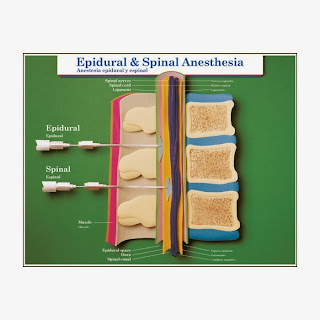Anesthesia ✿
Anesthesia:
- Epidural anesthesia is regional anesthesia that blocks pain in a particular region of the body. The goal of an epidural is to provide analgesia, or pain relief, rather than anesthesia which leads to total lack of feeling. Epidurals block the nerve impulses from the lower spinal segments. This results in decreased sensation in the lower half of the body. Epidural medications fall into a class of drugs called local anesthetics, such as bupivacaine, chloroprocaine, orlidocaine. They are often delivered in combination with opioids or narcotics such as fentanyl and sufentanil in order to decrease the required dose of local anesthetic. This produces pain relief with minimal effects. These medications may be used in combination with epinephrine, fentanyl, morphine, or clonidineto prolong the epidural’s effect or to stabilize the mother’s blood pressure.
- A Spinal Block is sometimes called a “spinal.” In this procedure, a narcotic or anesthetic such as fetanyl, bupivacaine or lidocaine is injected below the spinal column directly into the spinal fluid to provide pain relief for as long as 2 hours. It is easy to confuse a spinal block and spinal epidural because they are both injections into the spinal area. For a spinal block, narcotics or anesthetic is injected once with a needle. For a spinal epidural or combined spinal epidural, a catheter is placed in the epidural space to allow continuous anesthesia. Spinal blocks are not widely administered today because of the preference for epidurals. However, they can be used in a more complex birth situation or a cesarean delivery.
- Local anesthesia is injected into a specific area to provide pain relief. Local anesthesia is given through various medications and dosages in the form of epidurals, pudendal blocks, and spinal blocks. It is also given near the end of birth for an episiotomy, to relieve the discomfort of the perineum stretching and also after birth to repair tears and episiotomies. When used at the end of birth or after birth, medication such as procaine(Novocain), lidocaine (Dalcaine, Dilocaine, L-Caine, Nervocaine, Xylocaine), and tetracaine (Pontocaine), is injected into the skin, muscle, or cervix for the fast, temporary relief of pain in the perineal area. Though rare, local anesthesia may be injected into the perineum when the baby’s head position will not allow a pudendal block to be administered. This will ease the pain of the perineum stretching, but will not relieve the discomfort of contractions during labor.
- Being informed about General Anesthesia will help prevent mothers from being caught by surprise in the unlikely event that it might be necessary. General anesthesia causes a total loss of both sensation and consciousness. It is rarely used for childbirth because a mother’s conscious participation is regarded as highly important for a safe and efficient birth.




Eu acho que só me vou ver livre dos enjoos quando o meu príncipe nascer :|
ResponderEliminarEsperemos que eles comecem a 'aliviar' um pouco Querida!
EliminarSenão é mesmo até nascer....